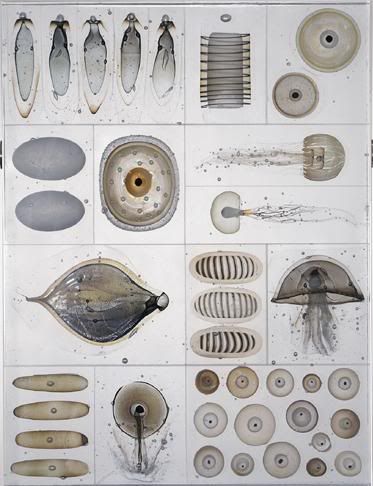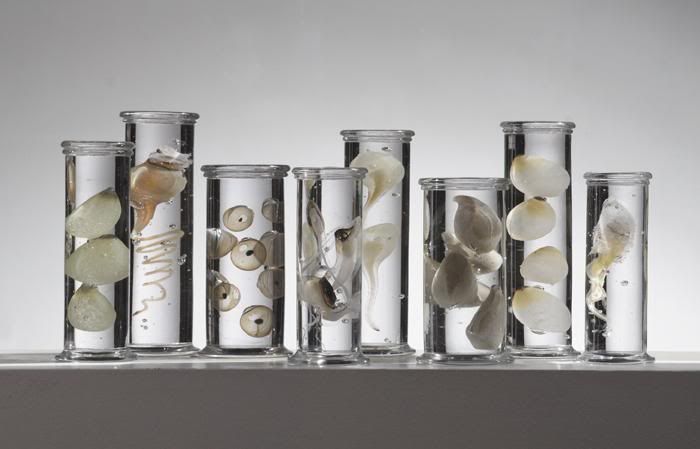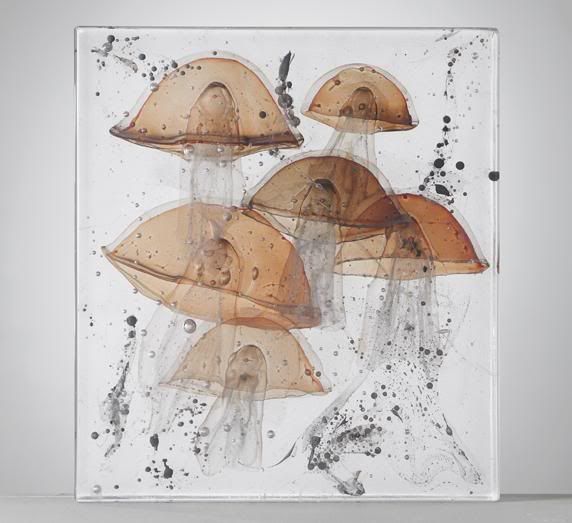http://www.damogkarlslundglas.dk/showpage.aspx?sideid=61
From an early age, I’ve been fascinated with collections and curio’s of the natural world. Those old cabinets in dusty museums, the creatures slightly scuffed and brown or pale with age, pinned to a board or suspended in some jelly like preservative, limp, pale and empty.
The process of having to capture, kill, then preserve an animal stimulated my sense of the macabre, these weren’t just naturalists, these were invertebrate murderers to my childlike imagination, beastie’s plucked from their habitats, leaving a hole, possibly being missed… I always applied some sort of Greek tragic element to everything and to a certain extent still do, taking a point of view that somehow there would be a butterfly “wife” missing her butterfly “husband” and these crying caterpillar babies… ! And the process of capturing these creatures, who were these men and women, where did they walk? Who did they meet along the way?
So when I walked into this particular gallery and saw the beautifully lit collections, pristine, not sad or mournful, but bright and vibrant, I thought wow! Until I saw the price that is (some pieces were around £12k), then the reaction was still wow! But with the added incentive not to touch or break anything with my clumsy Mediterranean paws.
All of the images are taken from his website…. firstly a picture of the artist, he is Danish, he is making of one his jellyfish like specimen creations from the look of the work. I believe it is the law that all Danish men of an artistic temperament must look like this, I bet Hans Christian Andersen did too.. although I’ve just googled him and he doesn’t look like this at all, so that’s blown that theory.

We also ordered the catalogue of his work through an older exhibition, which was sold out at the time, but has recently arrived in the post. It’s awesome and contains some background information on his inspirations which of course includes the meticulous work of naturalists in building collections through history.

As to the work itself, the website can give you some excellent blow ups, but for now….

Yes… this is all glass work, no animals were harmed or involved in the making of this art…. nature was only used for inspiration.

Amazing fossil like image below

The man is unique!
But this brought me onto the second part of this particular blog entry… at the moment, the Natural History Museum has a special exhibition on called “The Deep”.
http://www.nhm.ac.uk/visit-us/whats-on/thedeep/index.html
Once again, as a child (my creative peak as a human being… it’s been downhill ever since), when I would flick through a book on fish or the sea, I always impatiently trawled through to the dark murky pages specifically focusing on those deep sea creatures, the frighteningly bizarre ones which dwell in the inky depths of the ocean. Those creatures who are so rarely caught and never observed in their natural habitat, we know very little about them beyond what we can glean from their corpses, they exist in a world which is still the last place on Earth yet to be fully explored and discovered. They look grotesque, with their massive eyes or their lack of eyes, their huge mouths, their monstrous teeth, distended jaws, lanterns and filaments, long bodied or stout. These creatures are frightening. And it seems the impressions of this undersea world gave the artists of these old nature books some creative license from the monotony of drawing “normal” sea life, bringing them horribly to life in these black pages, with the occasional flash of light, generated from within the creature itself or shone on it, like some ghostly wisp.
What is it like living so far under the ocean, where these creatures, whose bodies have evolved so well to the water pressure, a pressure which could crush a human in seconds? Well, this exhibition does it’s best to explain. It focuses on the Natural History (as you would expect) but also on the exploration of the depths, from the voyage of HMS Challenger a research vessel travelling to the arctic then up through Australian waters, New Zealand and the Pacific / Japan in the 1870s, to voyages in such marvellous inventions as bathysphere’s (a tiny two man submersible used in the 1930’s). As well as this there is a cool recreation of a deep water sub you can pretend to drive (I was on my own, and even though I wanted to shove the kids out of the way and take the controls I felt this would have been inappropriate).
Anyway, I’ve taken some photo’s of “Things in jars” from the exhibition, just a little bit like Steffen Dam’s work…. enjoy.









And not forgetting this absolutely terrifying “mermaid”

